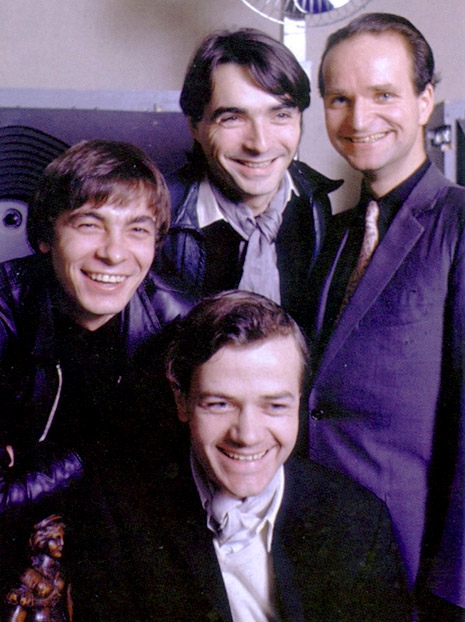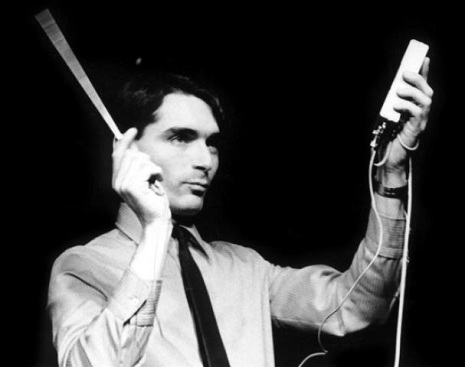
You know those Pink Floyd laser shows that set trippy visuals to either the entire Dark Side Of The Moon album or to a hodgepodge of greatest hits? Imagine being at one of those, but Roger Waters is there. In fact, he’s not just there, he’s onstage. And not only is he onstage, he’s holding his bass. There are also three other guys there whom you don’t recognize, and they have instruments too—you can’t really tell if anyone’s actually playing the instruments, but you give them the benefit of the doubt that they probably are; anyway, live music is utterly beside the point of the show, you’re really there to be dazzled by the visuals. Now imagine that’s not a Laser Floyd show—imagine that Waters is representing this event as an actual Pink Floyd concert and charging accordingly for tickets, despite the SCREAMING obviousness of the fact that this is in no way the Pink Floyd the world grew to love, and seriously, who the fuck are these old men with the other instruments?
This is not an invented scenario, and it’s not Pink Floyd. I have basically just described a 21st Century Kraftwerk show.
Some of the commentariat will surely howl for my head over that, but whatever. The truth, in retrospect, is obvious: the Kraftwerk that was every bit as important to the development of Western pop music as Elvis, the Beatles and the Ramones has been stone cold dead for at least 25 years. The four-piece lineup that produced the string of five literally world-changing albums from 1975’s Radio-Activity to 1986’s Electric Cafe began to splinter when in 1987 percussionist Wolfgang Flür departed, followed by percussionist Karl Bartos in 1990. Their next album was a 1991 best-of that offered contemporized versions of their classics, but no new compositions, signaling that Kraftwerk were no longer the future, but a holdover to what the future once promised. Both percussionists were replaced on that album,The Mix, by Fritz Hilpert, who remains a member to this day.
Kraftwerk began touring in earnest again in the late 90s, adding sound engineer Henning Schmitz to the lineup, restoring the quartet formation that had figured so importantly in their visual presentation. They FINALLY released new material in 2003—though to consider it entirely new is a stretch, as the album, Tour De France Soundtracks, was built around a re-working of the “Tour De France” single from 20 years earlier (a magnificent song), and it’s their least essential post-Autobahn work. Kraftwerk’s founders and principal songwriters were synthesists Ralf Hütter and Florian Schneider (who himself jumped ship in 2008), but the fact that they never recovered artistically after the losses of Flür and Bartos strongly suggests that those percussionists may have been more crucial to the band’s creative nexus than the bossmen were ever willing to say.

If you don’t love this photo I may be incapable of understanding you.
I’m very glad to have seen their 1998 tour, though it was a pretty gimmicky affair; it was crowd-pleasing and great fun, but that was when it really hit me that Kraftwerk had become a nostalgia act packed with placeholder members. Their tours had long deployed stagecraft that was conceptually germane to the band’s obsessions—typically a variation on the theme of artificial humanity, expressed via dummies, automata, computer modeling—but that tour was a backward glance, the presentation of every song adhering strictly to the cover design of whichever album it had come from. Lately, the Hütter-led Kraftwerk cover band also called Kraftwerk has been packing ‘em in on a “3D” tour that is essentially nothing but its visual gimmick. They’re scheduled to perform eight Kraftwerk albums in their entirety in Oslo this summer, with the 3D visuals, which will surely be much more fun to look at than four old men in form-fitting catsuits standing still behind podia.
But as far as music goes, those departed percussionists haven’t simply disappeared, and in fact have had vastly more active release schedules than their ex-bandmates who continued to keep the name “Kraftwerk” going. Bartos collaborated with members of New Order and the Smiths in a project called Electronic, and remained active in the ‘90s with his own project Elecktric Music. His pace has since slowed. In 2003 and 2013 he released albums under his own name, which are quite enjoyable, but VERY throwbacky—the cover art for the most recent, Off the Record, even depicts Bartos as an unmistakably Kraftwerkian mannequin.
Wolfgang Flür has remained an active presence in electronic music as well. In 1993 he founded Yamo, a collaborative project with Düsseldorf electronic experimentalists Mouse on Mars, that released an album, two EPs, and two singles in a concentrated spurt from 1996-98. Since Yamo he’s been DJing and composing, lately doing a multimedia show called MusikSoldat:
Recently, a compilation of Flür’s post-90s music called Eloquence was released. It features solo works and collaborations, including the later Yamo single “I Was a Robot,” the significance of which surely can’t be lost on anyone still reading this. (It was also the title of his autobiography). The comp reveals that though Bartos is probably the most prolific when it comes to releasing, Flür may actually be the most creatively vital Kraftwerk member at work today, and his penchant for collaboration may be key to that. His track with Meat Beat Manifesto’s Jack Danger sounds unmistakably like a combination of that band with Kraftwerk. “Axis of Envy,” his work with Nitzer Ebb’s Bon Harris, unsurprisingly bears strong currents of industrial menace. “Moda Makina,” with Nortec Collective’s Ramón Amezcua, seems like an answer song to Kraftwerk’s much-covered “The Model,” (perhaps a favorite topic of his—there’s also a song called “Cover Girl” that covers similar conceptual territory) but with a Mexican horn section. Farther from his old group than that, I doubt one could get.
Flür talks more than he sings—he’s addressed this himself, saying “Eloquence shows my way of performing most of songs as a story-teller than a vocalist. I slip into roles like an actor inside the song, trying to be the character within the song”—and while that can sometimes be Leonard Cohenishly effective, that’s not always so, and perhaps recognizing this, he turns the vocals over to guests from time to time, as on a Japanese language version of “On The Beam,” sung by Pizzicato Five’s Nomiya Maki.
Flür was gracious enough to answer a few questions in an email exchange.
DM: It seems like a good bit of your output during and since YAMO has been collaborative. I imagine, given your history, that you must be a sought-after collaborator. How do you choose the artists with whom you’ll work?
Wolfgang Flür: It seems so, sought-after, and I’m very happy about this situation. Having so many friends and colleagues in the world is really making me a happy man. Being involved in so many interesting and different projects is something I could not believe twenty years ago. I choose what inspires me what touches my heart and soul. I immediately feel a familiarity when certain things come together.
DM: Does the release of your retrospective herald a new productive phase for you in terms of releasing more of your own compositions?
WF: Of course is it this. I had much fun with all of the ELOQUENCE productions. Next time I maybe call my album “COLLABORATIONS“
DM: Is anything stopping you from forming a new group with Karl Bartos and Florian Schneider? What would that group sound like in 2015?
WF: That’s a question I’m often asked and also this time I answer, I’m open for everything which is fun. Have you watched what Florian is currently in? I’m proud of him and say “chapeau!“:
After the jump, some music…






